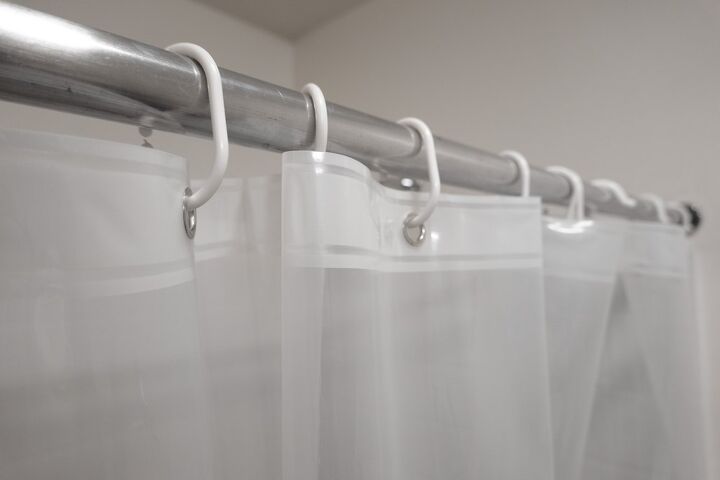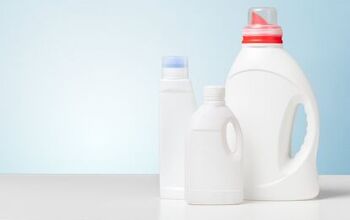Can You Recycle Shower Liners? (Find Out Now!)

Shower liners keep your bathroom and shower curtain clean and dry. With regular use, the material of the liner breaks down, and it’s time to replace it. Before you toss it in the trash, there’s one question to consider – can you recycle shower liners?
Recycle shower liners made from PEVA and fabric, such as polyester, cotton, and nylon. Plastic, PE, and PVC shower liners are not recyclable. Use them for tarps, floor coverings, potty pads, picnic mats, rain gear, non-slip mats, bibs, bags for wet clothes, and mud mats. Check your local sanitation department for how to dispose of PE, and PVC shower liners.
Shower liners are made of several materials. Some can be recycled while others cannot.
What are Shower Liners Made Of?
At first glance, shower liners appear to make made of simple plastic. In reality, they are made with advanced synthetic materials that are treated to resist water, mold, and mildew.
The most common materials that are used for shower liners are polyethylene (PE), polyvinyl chloride (PVC), polyethylene vinyl acetate (PEVA), and fabric.
PE is the most common form of plastic that is used in household products. It is also used in some commercial applications, such as plastic grocery bags, plumbing pipes, medical devices, and even bullet-proof vests. Shower curtains that are made with polyethylene come in many colors, including clear, and they are very thin.
Add chlorine to PE, and you’ll get PVC. The key difference is that PE is flammable, and PVC is self-extinguishing. PVC is a denser material than PE. The composition of PVC shower liners creates fumes that may cause symptoms in people with respiratory illnesses and allergies.
PEVA is an alternative to vinyl. These are the most eco-friendly of shower liners. It is also a good material if you want to reduce the amount of volatile organic compounds (VOC) in your home. PVC shower liners tend to be more expensive than other types of shower liners.
Fabric shower liners are made from cotton, polyester, or nylon. The liners are water-resistant. They are not treated to resist mold and mildew; therefore, you need to wash your fabric shower liner regularly.
Can You Recycle Shower Liners?
Whether or not you can recycle your old shower curtain liner depends on the type of material used in the construction.
Can You Recycle Plastic Shower Liners?
Plastic shower liners are made from PE or PVC. Certain forms of these materials can be recycled. Unfortunately, the PE and PVC used for shower liners are low density. The shower liners cannot be recycled.
Are PEVA Shower Liners Recyclable?
Not only is PEVA better for you, but it is also better for nature. The material is 100% recyclable. Check with your local recycling center to find out how to recycle your old PEVA shower liners.
Can You Recycle Polyester Shower Liners?
Polyester, cotton, and nylon shower liners can be recycled. These materials are often reused for post-consumer products. Your local recycling center can let you know how to have your old fabric shower liners recycled.
How to Dispose of an Old Shower Curtain Liner
If recycling is not an option for your old shower liners, there are only two options – dispose of the shower curtain or repurpose it. With so many of our landfills being overwhelmed, consider how you can upcycle your shower liners.
How to Reuse Shower Liners
Here are some creative and practical ways to reuse your old shower liners.
- Tarps: Plastic, PE, PEVA, and PVC shower liners make excellent tarps. Use them outdoors to cover patio furniture, firewood, and anything else that needs to stay dry.
- Floor Covering: Are you into DIY projects? Do your children love messy projects? Fold up your old shower liners, and store them. The next time you need to protect your floors and furniture, use the old shower liners.
- Potty Protection: Old shower liners are great for use with puppy pads and to protect a bed when you are potty training your child.
- Picnic Mat: Wet grass ruins a good picnic. Keep a folded shower liner in your trunk. Lay it out under your favorite picnic blanket.
- Rain Gear: Cut a hole in your old shower liner for an instant rain poncho. Keep it in your backpack or trunk.
- Non-Slip Mat: Cut old shower liners into small squares. Use them under pet bowls and to keep your area rugs in place.
- Bibs: Cut a piece of your old shower liner, and attach straps. The bibs are easier to clean than fabric, and they are great replacements for disposable bibs.
- Wet Clothes Bag: Do a little sewing, and convert your old shower liner into a bag for wet clothes. Take it with you when you go swimming or hiking.
- Mud Mat: If your floors get covered with water, dirt, and mud on a regular basis, your old shower liner can help. Cut a piece that is the size of a doormat. Put it next to your front or back door. As people come inside, they can remove their wet, muddy shoes, and put them on the plastic. Dress up your shower liner mat by making a fabric cover for it.
Related Questions
Why does my shower liner turn orange?
Orange stains on your shower liner may be from your bath products. The stains may also be caused by your water. Iron in the water discolors shower liners, fixtures, and ceramic. Clean the liner with baking soda or vinegar to remove the stains.
Can you wash a plastic shower liner?
You can wash a plastic shower liner. Use the gentle cycle. Don’t put the liner in the dryer. The heat melts the material. Hang it in the shower to dry.
Conclusion
Looking for ways to keep items out of the landfills is a great way to protect the environment. Some shower liners can be recycled. For those that cannot be recycled, repurposing is a great option. When you replace your shower liners, be sure to choose materials that are 100% recyclable, such as fabric and PEVA.
Related Guide

Jennifer L. Eggerton loves being hands-on, whether it's with a home DIY project, making repairs, re-decorating a room, or keeping life organized. She enjoys helping people by sharing her knowledge, insights, and experiences, as well as her lessons learned. In addition to her work as a writer, Jennifer is a Jeep® overlander, self-published author, and nature photographer who loves being outdoors.
More by Jennifer Eggerton



























